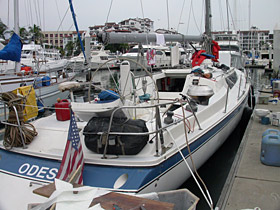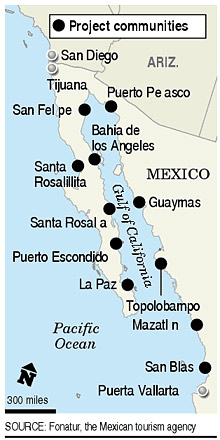 |
 |
 |
 News Around the Republic of Mexico | October 2005 News Around the Republic of Mexico | October 2005  
Mexico's Bid to Lure Boaters a Tough Sale
 Sandra Dibble - Union-Tribune Sandra Dibble - Union-Tribune


| | Environmental groups fear the nautical stops could prompt unregulated growth from private developers. |
Mexican President Vicente Fox called it "a stairway to prosperity," a tourist mega-project to draw boaters and investors to the Gulf of California region through a series of linked ports. Now 4˝ years later, the controversial Escalera Nautica, or Nautical Ladder, appears to be moving forward, but with a new name and a broader mandate.

Rechristened El Proyecto Mar de Cortés, or the Sea of Cortez Project, the plan calls for 28 nautical stops in five states, with 11 to be in place by May, according to the Mexican tourism development agency, Fonatur. The plans also call for the completion by May of a "land bridge" that would allow boats to be towed across the Baja California peninsula from Santa Rosalillita on the Pacific coast to Bahia de los Angeles.

"The impact is minimal," Francisco de la Vega Aragón, a top Fonatur official, said during a recent visit to Tijuana. "What we're trying to do is regulate and put in services for travelers."

But Fonatur's critics have been less than enthusiastic about the revised proposal, saying the agency hasn't made available detailed plans and that it has a poor track record of following through. And while the stops themselves may be modest, environmental groups fear those stops could prompt unregulated growth from private developers.

"Fonatur is like a chameleon," said Lorenzo Rosenzweig, executive director of the Mexican Nature Conservation Fund. "Every time they feel the heat of criticism, they modify and change the name. It's a moving target."

 The central idea, which predates the Fox administration, remains unchanged. Fonatur's plan is to encourage greater numbers of boaters – most of them from the United States – to visit the region, eventually offering them a series of linked marinas no more than a day's sail apart. Some marinas are in established ports such as La Paz and Mazatlan, while others are in isolated coastal communities with few amenities. Fonatur hopes that when the public infrastructure is in place, the private sector will follow. The central idea, which predates the Fox administration, remains unchanged. Fonatur's plan is to encourage greater numbers of boaters – most of them from the United States – to visit the region, eventually offering them a series of linked marinas no more than a day's sail apart. Some marinas are in established ports such as La Paz and Mazatlan, while others are in isolated coastal communities with few amenities. Fonatur hopes that when the public infrastructure is in place, the private sector will follow.

"We're coming to regions of great poverty, and bringing significant investment," said Archibaldo Pérez, an official with Singlar, a Fonatur subsidiary that is developing the marinas. "Once we've developed a critical mass, private investment will join in."

As far as size of marinas, the new Proyecto Mar de Cortés appears to be scaled down from the Escalera proposal. But the project also has expanded the scope of the earlier proposal to include infrastructure in communities that lack basic services. It also contemplates the creation of "tourism circuits" that would take visitors to inland cultural and natural sites.

José Luis Luege Tamargo, Mexico's secretary of the environment, said this month that his agency has approved an overall land-use plan for the region and is evaluating Fonatur's individual proposals for nautical stops.

The Fox administration's Escalera Nautica, launched in February 2001, initially envisioned 50,000 boats and 1 million visitors drawn annually to the region by 2014, most of them from the western United States. Fonatur's proposal spoke of airports, golf courses and five-star hotels along some of Mexico's most pristine shorelines. The Fox administration committed $220 million to the project, hoping to lure $1.7 billion in private investment.

Fonatur promised the Escalera Nautica would bring jobs and better standards of living to areas that have few schools, hospitals and economic opportunities.

But environmental groups were fiercely critical of the plan, saying it would overwhelm and degrade a region much prized by naturalists. Earlier this year, the United Nations bestowed "World Heritage Site" status on 244 uninhabited islands in the Gulf of California, also known as the Sea of Cortez.

Despite the continued skepticism of environmental groups, Fonatur officials promoting the Proyecto Mar de Cortés are saying their marine installations will now be minimal.

"With the Escalera Nautica, they considered marinas that would be destinations. Now they're just marinas for transit," said Singlar's Pérez. "What we're trying to do will have a very low impact."

But Fonatur has done little to alleviate fears. The agency's Web site provides few specifics of what it intends to build, such as how many boat slips are planned at the marinas scheduled to open next year. Pérez said the information is still being loaded onto a Web site, www.regionmardecortes.com.

Fonatur officials interviewed in Tijuana this month gave some information about their plans. The agency plans to spend $26 million on the project in the state of Baja California, de la Vega said. Of the 11 stops to be opened on the mainland and the peninsula, five will get a range of public projects, such as sewage treatment plants, streets, drainage systems and sea walls. Fonatur is developing master plans to guide future growth, de la Vega said.

He said the centerpiece of the project – the "land bridge" allowing boats to be towed between Santa Rosalillita and Bahia de los Angeles, thus avoiding a lengthy trip around the peninsula – should be complete next year. Construction of a key stretch of the road that runs through the Valle de los Cirios, a protected area, was stopped because the federal Secretariat for Communications and Transportation failed to obtain an environmental permit; an official with the secretariat said this month that it has been given the green light.

The marinas at Bahia de los Angeles and Santa Rosalillita, which have elicited concern from environmental groups, will have slips for no more than 30 boats under the new plan, de la Vega said.

He said that to minimize environmental impacts, Fonatur is looking into placing floating marinas at four locations in the Gulf of California. One could be at Bahia de los Angeles. The community of 600 is a particularly sensitive location because it's a launching point to the central gulf and the focus of conservation projects.

At the western end of the land bridge, in Santa Rosalillita, breakwaters for a new marina are already in place, but environmentalists say constant dredging will be required as ocean currents wash in sand.

"It's a disaster," said Fernando Ochoa, of Environmental Defense of the Northwest. "The effect on the coastline has been terrible. There have been no benefits to the community."

Singlar's Pérez said the accumulations will end once the marina is in operation. Santa Rosalillita residents will soon see improvements, Fonatur officials say, with amenities such as a gas station, a sewage treatment plant and an electric generator.

Fonatur is also building marinas in larger communities such as La Paz in Baja California Sur, and marina owners there say they aren't needed.

"There are low occupancy rates already," said Malcom Shroyer Shoen, regional vice president for the Mexican Association of Tourist Marinas. "They should build where nobody else is building. Except for Santa Rosalillita, they've abandoned all the Pacific coast in terms of trying to get these rungs in."

To monitor Fonatur's plans, 22 environmental groups in the region have formed an alliance called Alcosta.

"We need more details," coordinator Sandra Guido said. "Nobody has the complete picture. . . . Whether or not the results are positive depends on how it's implemented, on who takes responsibility for the environmental and social impacts." | 
 | |
 |



